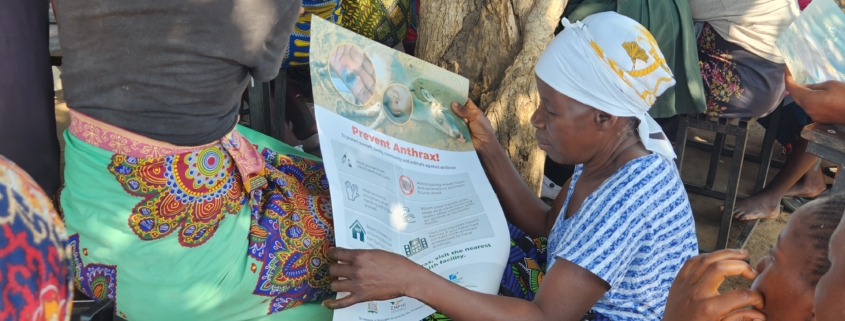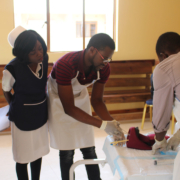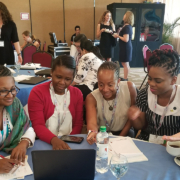Please Mind the Gaps: Addressing the Knowledge and Behavioral Gaps Around Zoonotic Diseases in Zambia
One in every two Zambians lives in proximity to livestock, heightening their risk of contracting anthrax and other zoonotic diseases, which are diseases that spread between animals and humans. However, a new Breakthrough ACTION study found that zoonotic diseases, including anthrax, barely register as a health concern among participants in the study. The study also identified other similarly worrying gaps. To address the threats of zoonotic diseases in Zambia, public health professionals must first understand these gaps.
Mismatch Between Real and Perceived Risks of Zoonotic Diseases
Public health professionals cannot adequately address a health threat if communities do not perceive the risks. Despite recent anthrax outbreaks, study participants were unconcerned about the threats zoonotic diseases posed to their health. When asked about their top health concerns, participants were quick to point out symptoms such as coughs and diarrhea instead of specific diseases. Others cited challenges such as clean water and accessibility to health facilities. Rarely do zoonotic diseases enter into conversation unpromoted. Those aware of anthrax often viewed the disease as a risk to livestock rather than humans. Some participants even expressed doubt that anthrax exists, with a male community member from Kazungula stating, “Anthrax, we don’t take that it kills. We just take that it that it is a story. Because it has never hit us here.”
Insufficient Knowledge About Symptoms, Prevention, and Treatment
Only a handful of participants could name anthrax symptoms. For instance, a female community member from Kazungula claimed that anthrax symptoms, which include bodily sores and flu-like symptoms, could be mistaken for COVID-19. This is disconcerting because the inability to identify symptoms can hamper care-seeking.
Misconceptions about anthrax transmission were also common. Some believe that it spreads person-to-person instead of animal-to-person through open wounds, eating infected meat, or inhaling anthrax spores. Others attributed anthrax to witchcraft. Slaughtering livestock without protective gloves or boots was common practice because they did not know about such preventive behaviors. Without correct information about the causes or modes of transmission, people cannot adopt appropriate safety measures.
While anthrax can lead to death, it is treatable with antibiotics. However, misconceptions about the treatability of anthrax persist. A male community member from Kazungula states, “[Anthrax] has no cure. Once you get sick of it, you die.” The belief that anthrax is an automatic death sentence can prevent people from seeking treatment, resulting in unnecessary loss of life.
Dissonance Between Desired and Practiced Behaviors
Unfortunately, knowledge does not always translate to action. A variety of factors drive people to engage in risky behaviors even when they know better.
“Poverty makes us people get into doing wrong things even when we know that is not right,” explained a female community member from Senanga. “Even our neighbors can know exactly how the cow died, but instead of them encouraging us to burn it, they come with money in order to buy some.” In some cases, livestock owners may know they should burn animals that died of anthrax but fail to do so because they have neither the money for fuel nor the time it takes to burn the dead animal to ashes.
Sometimes, a lack of trust, not resources, discourages people from doing the right thing. While many livestock owners are convinced about the benefits of vaccinating their animals, some choose not to do so because do not trust that veterinary workers will administer high-quality vaccines.
Bridging the Gap to Safety
The challenges arising from a deficit of knowledge, resources, and trust seem insurmountable, but there is reason for hope. The study identifies three promising strategies for public health practitioners, namely working with trusted leaders and champions who can serve as information sources and reinforcers of healthy behaviors, crafting nuanced messages that target specific concerns, questions, or misinformation, and raising awareness of poorly understood topics.
Implementing these strategies requires multi-sectoral collaboration. Alick Mwanza, Breakthrough ACTION Zambia Research Coordinator, emphasizes, “Bringing representatives from animal health, human health, and environmental health together around research findings is critical for generating multi-sectoral and effective solutions.”
Fortunately, key stakeholders recognize the need to address the threat of zoonotic diseases, and they are ready to act together. “Zambia undertook a prioritization exercise to rank zoonotic diseases of greatest concern in Zambia and is conducting joint risk assessments for these priority zoonotic diseases. This will result in a coordinated One Health approach to mitigating the threat posed by zoonotic diseases,” notes Raymond Hamoonga, National One Health Coordinator in Zambia.
By uncovering the knowledge, attitudes, and behavioral gaps around zoonotic diseases, Breakthrough ACTION Zambia is paving the way for safer coexistence between people and animals in Zambia, thus reducing the risk of zoonotic disease outbreaks.
Written by: Meei Child, Communications Officer, Breakthrough ACTION

 Jessica Phiri/Breakthrough ACTION
Jessica Phiri/Breakthrough ACTION Poravute/Getty Images
Poravute/Getty Images Sean Maloney/Breakthough ACTION
Sean Maloney/Breakthough ACTION Anne Ballard Sara/Breakthrough ACTION
Anne Ballard Sara/Breakthrough ACTION
 K4Health
K4Health
